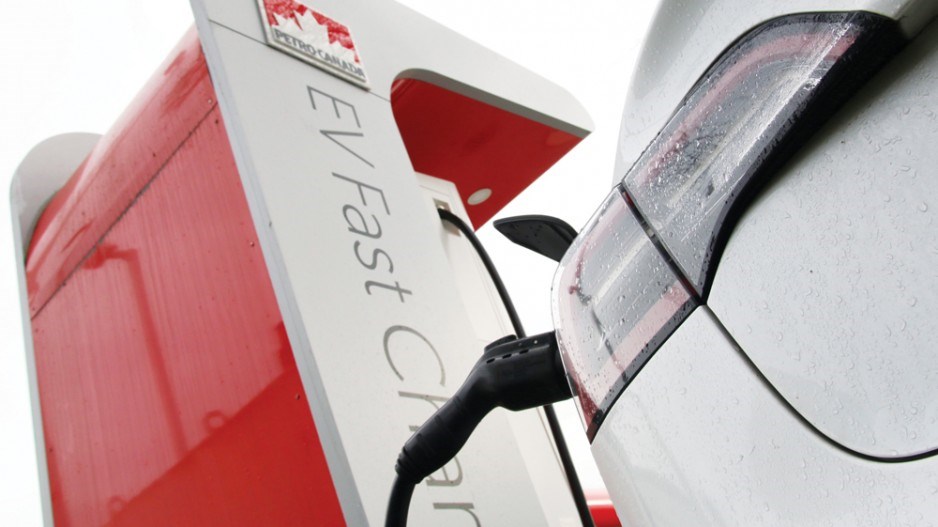The roller-coaster ride that is B.C. gas prices over the past month has been affecting more than just local vehicle traffic.
A recent Canada Drives Ltd. blog post delving into electric vehicles (EV) saw web traffic jump 423 per cent after gas prices began skyrocketing late last month amid Russia’s invasion of Ukraine.
“This is a pretty profound change in a very short period of time,” Cody Green, co-CEO of the Vancouver-based online car vehicle sales company, said in reference to gas prices.
“What people are experiencing at the pumps right now is they filled up for $75 last week and now it’s $100 this week. And that’s enough to have people be, ‘OK. Is this the vehicle I need?’”
But experts differ on whether recent astronomical leaps in gas prices will give way to a surge in EV adoption, owing both to supply and infrastructure challenges. Instead, government mandates for zero-emission vehicles (ZEV) may prove more influential in the long run than the present uncertainty at the pumps.
“We’ve always had waiting lists but never this long,” said ZEV expert Matthew Klippenstein, a regional manager with the Canadian Hydrogen and Fuel Cell Association.
He’s been visiting and calling dealerships for Ford Motor Co. (NYSE:F), Hyundai Motor Co. (KRX:005380) and Toyota Motor Corp. (TYO: 7203) to see what kind of demand there is for EVs right now.
Klippenstein said recent surges in gas prices are creating a spike in interest “that won’t immediately translate to sales because there are already six-plus-month waiting lists for most vehicles.”
Canada Drives’ inventory is stocked exclusively with used vehicles, which means the company is reliant on previous-year EV sales in order to meet current demand from customers.
It’s advertising nine electric or hybrid vehicles available within the B.C. market as of mid-March, with an additional four vehicles listed as “coming soon.”
Canada Drives operates in B.C., Alberta and Ontario, and Green said most demand for EVs is coming from the West Coast.
“We’re seeing a lot of people who’ve been thinking about it for a long time – this [surge in gas prices] being the push,” he said.
Judy Zaichkowsky, a Simon Fraser University marketing professor specializing in consumer behaviour, said the biggest challenge facing accelerated adoption of EVs is access to the necessary charging infrastructure.
Older buildings are less likely to have parking stalls outfitted with charging units, and few charging stations are dotting the streets relative to ubiquitous parking metres, she added.
“The biggest drawback to electric cars that people have is how [people are] going to charge them,” Zaichkowsky said.
B.C. is home to 60,000 electric vehicles and 2,500 public charging stations as of this year, according to the province.
The City of Vancouver, which requires new development permit applications to ensure 100 per cent of residential parking stalls be EV-ready, estimates its policies are creating 9,000 new residential charging circuits each year. There were 6,664 EVs registered within the city as of 2020, according to Insurance Corp. of British Columbia data.
“With historically high gasoline prices, we are seeing a surge in interest in EVs across the province. We are also seeing a strain on available product due to microchip and other supply chain challenges," Blair Qualey, president of the New Car Dealers Association of B.C. said in an email, "but thankfully more and more manufacturers will be offering new electric vehicles at a wide range of price points, so we are able to provide product for customers in many categories. In the coming years it’s fair to say that consumers will be [seeing] an avalanche of new EV models across manufacturers as consumer demand will always drive manufacturer investment.”
Meanwhile, infrastructure is steadily expanding ahead of ZEV mandates from both the province and Ottawa, which aim for 100 per cent of new passenger vehicles sold to be ZEVs by 2035. These ZEVs may either be battery-electric or hydrogen-powered electric vehicles.
And while U.S. President Joe Biden’s administration wants ZEVs to account for 50 per cent of new vehicle sales in the U.S. by 2030, B.C.’s mandate aims for 90 per cent of new vehicle sales to be ZEVs by 2030.
This is putting further pressure on manufacturers to meet both consumer demand and government mandates.
Some B.C. firms have revealed plans over the past year to shoulder part of that burden.
Vancouver-based ElectraMeccanica Vehicles Corp. (Nasdaq:SOLO) announced almost exactly one year ago that it had selected Mesa, Ariz., as its home base for manufacturing its flagship Solo vehicles in North America.
The U.S. plant is expected to begin producing the distinctive three-wheeled, single-passenger vehicles this year, and the company already has one manufacturing facility in China.
Electric-motorcycle maker Damon Motors Inc. officially broke ground last fall on its manufacturing hub in Surrey, where up to 40,000 motorbikes are expected to be produced annually once the plant opens later this year.
“So much of this is really driven by the manufacturers,” Zaichkowsky said. “It’s one thing to implement policy, but you also have to make sure that it trickles down to enable people to do it.”




